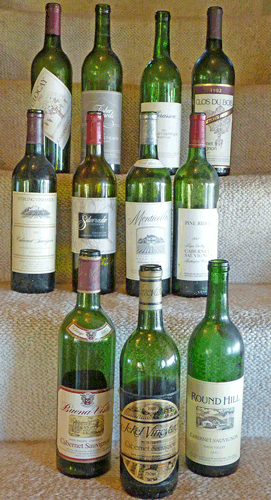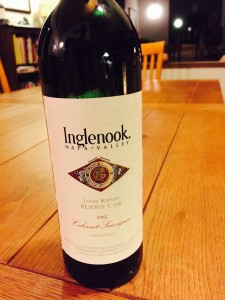 When I began drinking wine in 1970, Bordeaux was the standard by which all other Cabernet and Bordeaux-style blends were judged. At the time, it was understood that only the best wines benefited from age, and that aging was necessary to coax out the flavors in these wines. That wines were actually made with aging in mind was illustrated in a tasting of Lafite Rothschild in San Francisco in the 1980s. At that point, before the price of first growths had risen to ridiculous levels, I’d been able to do a first growth comparison every year for over a decade, and Lafite had never shown particularly well, usually coming in third or fourth behind Mouton, Latour or Haut Brion. I usually rated the fifth growth Lynch Bages above it. Perhaps smarting from our lackluster reviews, Eric de Rothschild put together a retrospective tasting for the Northern California wine press that included vintages from 1953 through the 1970s, designed to show us twits why his wine was at the top of the first growths and demanded respect. While I might still have my reservations about its value, I did learn something about how well those wines age, and why people of an earlier age put so much store in a wine’s age-ability. Lafite does improve dramatically with age, evolving from a tight, hard edged wine in its youth, to a supple, aromatic and complex wine in its maturity. The ’53, ’58, ’61, ‘64 and ’70 were all magnificent.At the same time there were those who scoffed at the idea that California wine could age. Three decades later I can state categorically that California wines do age. I admit that few people would bother, and many (if they were honest) would say they prefer younger, fruitier wines. But they do age; some age quite well, though the fact is that with few exceptions (Barolo and Port come to mind) most wines are no longer made to be aged. Nonetheless, I find that most California Cabernets and Bordeaux-style blends, as well as Merlot, Petite Sirah and Syrah are best (to my taste) after a dozen years in the bottle. I prefer Pinot Noir in its youth, but even there I’ve been surprised by how well they can age. When I began drinking wine in 1970, Bordeaux was the standard by which all other Cabernet and Bordeaux-style blends were judged. At the time, it was understood that only the best wines benefited from age, and that aging was necessary to coax out the flavors in these wines. That wines were actually made with aging in mind was illustrated in a tasting of Lafite Rothschild in San Francisco in the 1980s. At that point, before the price of first growths had risen to ridiculous levels, I’d been able to do a first growth comparison every year for over a decade, and Lafite had never shown particularly well, usually coming in third or fourth behind Mouton, Latour or Haut Brion. I usually rated the fifth growth Lynch Bages above it. Perhaps smarting from our lackluster reviews, Eric de Rothschild put together a retrospective tasting for the Northern California wine press that included vintages from 1953 through the 1970s, designed to show us twits why his wine was at the top of the first growths and demanded respect. While I might still have my reservations about its value, I did learn something about how well those wines age, and why people of an earlier age put so much store in a wine’s age-ability. Lafite does improve dramatically with age, evolving from a tight, hard edged wine in its youth, to a supple, aromatic and complex wine in its maturity. The ’53, ’58, ’61, ‘64 and ’70 were all magnificent.At the same time there were those who scoffed at the idea that California wine could age. Three decades later I can state categorically that California wines do age. I admit that few people would bother, and many (if they were honest) would say they prefer younger, fruitier wines. But they do age; some age quite well, though the fact is that with few exceptions (Barolo and Port come to mind) most wines are no longer made to be aged. Nonetheless, I find that most California Cabernets and Bordeaux-style blends, as well as Merlot, Petite Sirah and Syrah are best (to my taste) after a dozen years in the bottle. I prefer Pinot Noir in its youth, but even there I’ve been surprised by how well they can age.
1982 was an excellent vintage in both California and Bordeaux. I was lucky enough to taste many of them in the barrel on both sides of the Atlantic and upon their release a couple of years later. I stocked my cellar with them and enjoyed pitting them against each other for many years. By 1990, however, I’d finished most of my Bordeaux and could no longer afford to replace them, so I turned to California, becoming enamored of the 1987s, ‘89s, 91’s, ‘94s, ‘97s etc. In the ensuing years I forgot about the ‘82s, which lay quietly moldering in my cellar.
I recently began dragging them out for a reevaluation, and to taste them before they’d entirely withered (few Cabernets will survive to 25, let alone 30 years). While the process is not yet complete, I’ve come to some surprising assessments and a clear winner has emerged.
The wines tasted, in alphabetical order, were:
Buena Vista, Napa Valley – Carneros Clos du Bois, Proprietor’s Reserve, Dry Creek Valley Fisher Vineyards, Sonoma County Jekel Vineyards, Monterey Jekel Vineyards, Proprietor’s Reserve Mirassou, North Coast Monticello, Napa Valley Pine Ridge Rutherford Cuvée, Napa Valley Round Hill, Napa Valley Silverado Vineyards, Napa Valley Sterling Vineyards, Diamond Mountain Ranch, Napa Valley Tulocay, Napa Valley
While I could, with some effort, dig up the prices of these wines, I frankly don’t remember and it’s not terribly important, except to note that the Round Hill went for around $5, and the Pine Ridge, Monticello and Sterling were probably in the $12 to $18 range at the time of their release. At almost 30 years of age, most of the 1982s were over-the-hill, as you might expect — few wines will last that long. Of course, where they’re stored makes a great deal of difference. I recently had an excellent 1964 Charles Krug Cabernet Sauvignon, that had lain in the winery’s cellars for its entire life, never seeing the light of day and kept at optimum temperature and humidity. My own cellar is not as cool, but it does keep an even 62 degrees Fahrenheit year-round. Yet despite living on a foggy coast, all but one or two of the corks were dry and crumbled when extracted. I suspect it may have something to so with the corks being waxed, which keeps the wine from penetrating the cork. Only three wines were undrinkable — the Tulocay had turned to vinegar, the Pine Ridge (so fine at 13 years) was now sour, and the Jekel Vineyards Proprietor’s Reserve was clearly in the grave. The biggest surprise was the Round Hill. It hadn’t evolved at all. Likewise, the Mirassou was so fresh that it didn’t seem to have gained anything by the aging process. The others had all developed in the bottle to some degree, though I would not presume to suppose that those aged characters, ranging from mushroom to coffee to soy, would appeal to your palate.
There was, however, a clear winner. In 1984, writing reviews for Vintage Magazine and Wine & Spirits Buying Guide, I gave glowing reviews to the regular bottling of the Jekel Vineyard, Monterey, Cabernet Sauvignon, noting its lush layers of cassis, vanilla, coconut and chocolate, as well as a complex background of dried herbs. As an expression of gratitude, Bill Jekel sent me a case (the only time that has ever happened in over 30 years of reviewing wine). I remember that there was some controversy on the Vintage Tasting Panel, as my colleague Anthony Dias Blue found the herbaceous character far too strong for his tastes. With almost 30 years of age the cassis, vanilla, coconut and chocolate flavors were all still there, but the herbal notes had disappeared, replaced by black truffles and green tea. Incidentally, the cork was supple and saturated with wine.  1982 Inglenook, estate Reserve Cask Cabernet Sauvignon After completing the above paragraphs, I opened a 1987 Jekel, Arroyo Seco Vineyard, Cabernet Franc, which also proved to be age worthy. At 25 years, it had a deep core of black plum fruit, milk chocolate and coconut accents, and a complex minerality that played on the mid-palate and through the long, fading finish. This cork, too, was saturated and supple. & & & Update, February, 2015: Pulled a 1982 Inglenook Reserve Cask Cabernet Sauvignon from the cellar. At 32 and a half years of age, the cork was supple and came out in one piece. Upon decanting the nose showed some coffee and soy notes that quickly blew off, leaving a vibrant cherry and spice character, fully resolved tannins, fine depth and intensity, as well as subtle vanilla, cinnamon and mushroom notes to fill out the finish. Probably at its peak now, it would have have lasted another five years or more. |


I have a bottle of 1987 jekel cabernet sauvignon arroyo secco for sale if you’re interested email shank77tl@gmail.com